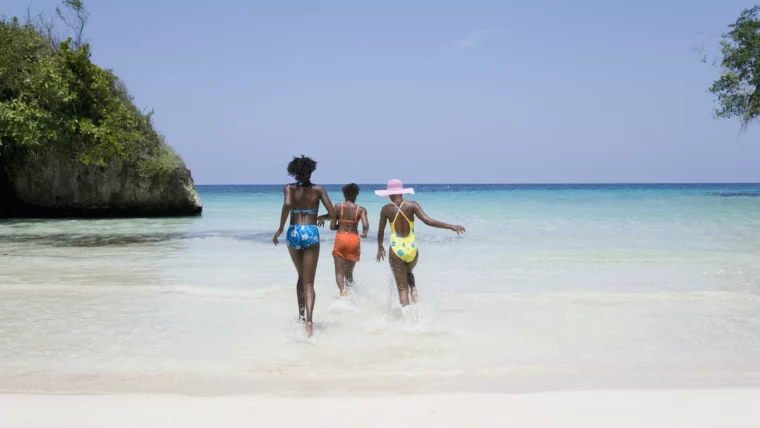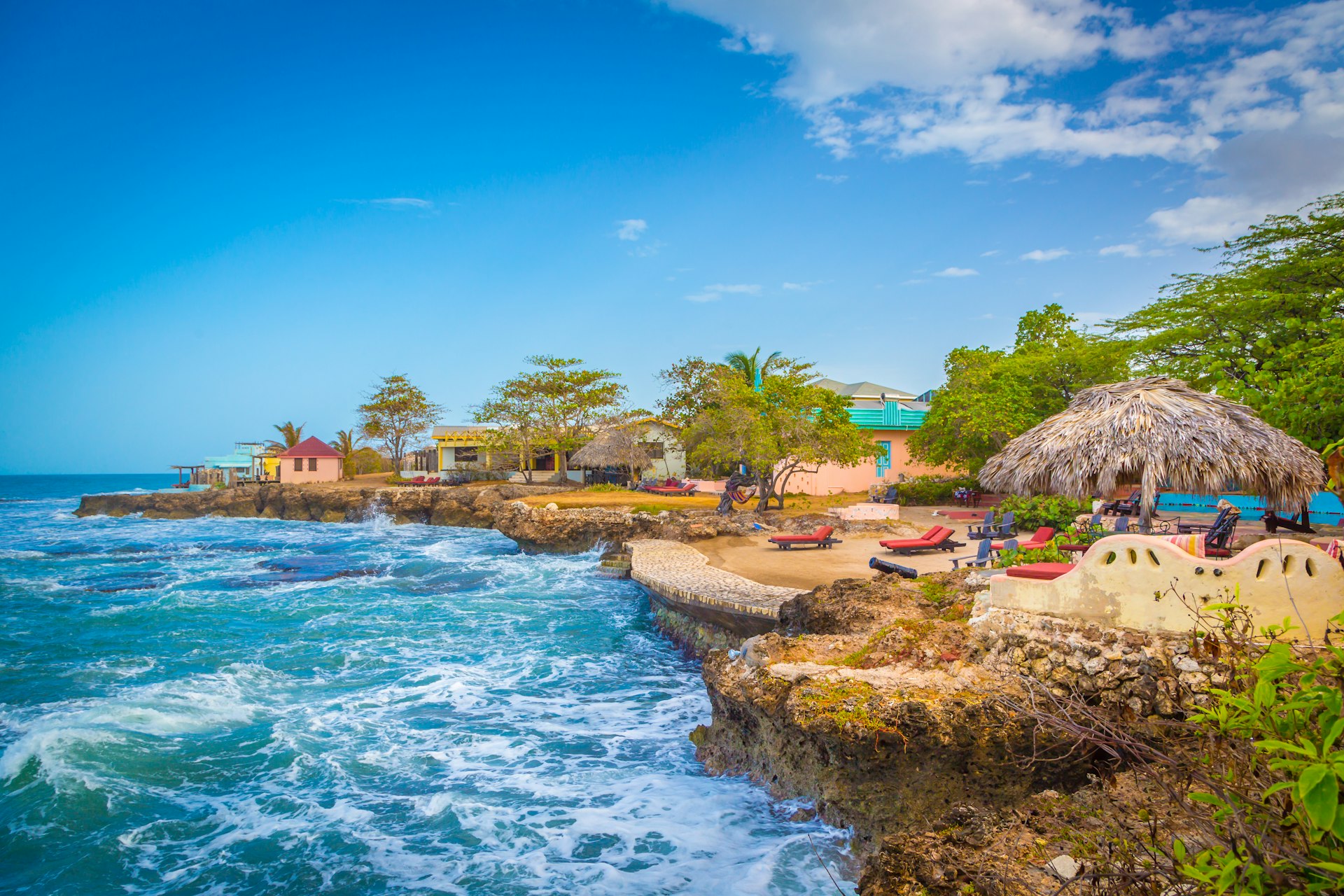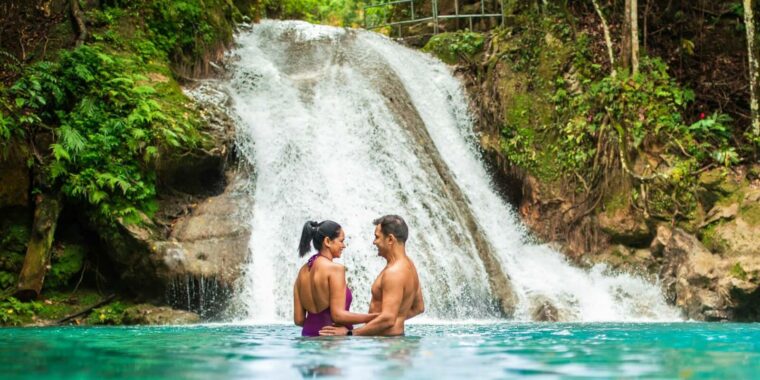Montego Bay, Jamaica Tours. One of the top attractions in Montego Bay is the famous Doctor’s Cave Beach. Known for its crystal clear turquoise waters and powdery white sand, this beach is a paradise for sunbathers and swimmers. The beach got its name from a famous British osteopath who claimed that the water had healing properties. Whether or not you believe in the healing powers, there’s no denying the beauty and tranquility of this beach.
If you’re an adventure seeker, Montego Bay has plenty to offer. You can take a thrilling zip line tour through the lush rainforest, where you’ll soar through the treetops and enjoy breathtaking views of the surrounding mountains and coastline. For a more laid-back adventure, you can go on a river tubing excursion down the Martha Brae River. Sit back and relax as you float along the river, taking in the stunning scenery and listening to the sounds of nature.
For those interested in history and culture, Montego Bay has a rich heritage to explore. One of the must-visit sites is the Rose Hall Great House, a grand Georgian mansion that is said to be haunted by the ghost of Annie Palmer, also known as the White Witch. Take a guided tour of the house and learn about the legends and stories surrounding this mysterious figure.
In addition to its natural beauty and historical sites, Montego Bay is also known for its vibrant nightlife. The Hip Strip is the place to be for those looking to dance the night away at one of the many clubs and bars. You can also try your luck at one of the casinos or enjoy live music performances at one of the beachfront venues.
When it comes to dining, Montego Bay offers a wide range of options to satisfy any palate. From traditional Jamaican jerk chicken and fresh seafood to international cuisine, you’ll find it all here. Don’t forget to try some of the local specialties like ackee and saltfish, a traditional Jamaican breakfast dish.
Whether you’re looking for relaxation, adventure, history, or a vibrant nightlife, Montego Bay has it all. With its stunning beaches, exciting activities, and warm hospitality, it’s no wonder that this Jamaican gem has become a popular destination for travelers from around the world.
For a truly unique beach experience, make sure to visit the famous Seven Mile Beach in Negril, just a short drive from Montego Bay. This stretch of pristine coastline is often ranked as one of the best beaches in the world. With its soft golden sands and crystal-clear waters, it’s no wonder why visitors flock to this beach year after year.
Seven Mile Beach offers a variety of activities for all types of beachgoers. Whether you’re looking to relax under the shade of a palm tree with a good book, take a leisurely stroll along the shore, or try your hand at water sports, this beach has it all. Snorkeling and scuba diving enthusiasts will be delighted by the vibrant coral reefs and diverse marine life just off the coast.
As the sun sets, Seven Mile Beach transforms into a lively hotspot for nightlife. The beach is lined with beachfront bars and restaurants, where you can enjoy delicious Jamaican cuisine and sip on tropical cocktails while listening to live reggae music. The atmosphere is electric, with locals and tourists coming together to dance, laugh, and create unforgettable memories.
If you’re in the mood for a more laid-back beach experience, head to James Bond Beach in Oracabessa. This secluded beach is named after the famous fictional spy, who was said to have frequented the area during the filming of the iconic movie “Dr. No.” Surrounded by lush greenery and calm waters, James Bond Beach offers a tranquil escape from the hustle and bustle of Montego Bay.
Whether you choose to explore the popular beaches of Montego Bay or venture out to the nearby gems, one thing is for sure – Jamaica’s beaches will leave you in awe of their beauty and charm. With their breathtaking landscapes, warm hospitality, and endless opportunities for relaxation and adventure, these beaches are truly a slice of paradise.
Discover Montego Bay’s Rich History
Montego Bay is steeped in history, and there are several historical sites that offer a glimpse into the city’s past. One of the most iconic landmarks is Rose Hall Great House. This grand Georgian mansion is known for its haunting legends and captivating history. Take a guided tour and learn about the infamous “White Witch” and the tales of the house’s former occupants.
Another historic site worth visiting is the Greenwood Great House. Built in the 18th century, this beautifully preserved plantation house offers a fascinating insight into Jamaica’s colonial past. Explore the elegant rooms filled with antique furniture and admire the stunning views of the surrounding countryside.
Aside from these two notable sites, Montego Bay is also home to the Sam Sharpe Square, named after the national hero who led the 1831 Christmas Rebellion. This historic square is a hub of activity, with its bustling market, local vendors, and vibrant atmosphere. Take a leisurely stroll through the square and immerse yourself in the rich cultural heritage of the city.
If you’re interested in learning more about the history of Montego Bay, a visit to the Montego Bay Cultural Centre is a must. Housed in the former Montego Bay Courthouse, this interactive museum showcases the city’s history through a variety of exhibits and displays. From the indigenous Taino people to the arrival of the Spanish and British colonizers, the museum offers a comprehensive overview of Montego Bay’s past.
For a deeper dive into the city’s maritime history, head to the Montego Bay Marine Park. This protected area is not only home to a diverse range of marine life but also houses the remains of several shipwrecks, including the famous “Kathleen” wreck. Snorkel or dive among the coral reefs and explore the underwater world that tells the tales of Montego Bay’s seafaring past.
Montego Bay’s rich history is also evident in its architecture. The St. James Parish Church, with its stunning Gothic revival style, is a testament to the city’s religious heritage. Dating back to the 18th century, the church has witnessed countless weddings, funerals, and community gatherings, making it a significant cultural landmark.
As you explore Montego Bay’s historical sites, take the time to engage with the locals and hear their stories. Whether it’s a friendly conversation with a market vendor or a guided tour led by a passionate historian, the people of Montego Bay are proud of their heritage and eager to share it with visitors.
While exploring Montego Bay, make sure to indulge in the vibrant and flavorful Jamaican cuisine that the city has to offer. The culinary scene here is a true reflection of the island’s rich cultural heritage and diverse influences.
One of the must-visit spots for food enthusiasts is Scotchies, a local gem that has gained international recognition for its authentic jerk chicken and pork. As you step into the restaurant, you’ll be greeted by the tantalizing aroma of the smoky flavors and spices wafting through the air. The secret to their mouthwatering dishes lies in the traditional jerk marinade, a blend of scotch bonnet peppers, allspice, thyme, and other herbs and spices. The chicken and pork are then slow-cooked over pimento wood, infusing them with a unique and irresistible flavor. Pair your meal with a refreshing Jamaican Red Stripe beer or a tropical fruit punch for the perfect combination.
If you’re a seafood lover, The Pelican Grill is a culinary haven that should be on your list. Nestled along the picturesque Montego Bay waterfront, this charming restaurant offers a wide range of delectable seafood dishes. From succulent lobster and plump shrimp to fresh fish prepared in various styles, you’ll be spoiled for choice. The Pelican Grill prides itself on sourcing the finest local ingredients, ensuring that each dish bursts with freshness and flavor. As you savor your meal, take in the breathtaking views of the turquoise Caribbean Sea and feel the gentle sea breeze caress your skin.
No exploration of Jamaican cuisine would be complete without trying the national dish, ackee and saltfish. This unique combination of the ackee fruit, which resembles scrambled eggs when cooked, and salted codfish is a true culinary delight. You can find this dish at many local eateries in Montego Bay, each with their own twist on the classic recipe. The creamy texture of the ackee pairs perfectly with the savory saltfish, creating a harmonious blend of flavors that will leave you wanting more.
Whether you’re a fan of fiery jerk chicken, succulent seafood, or the iconic ackee and saltfish, Montego Bay offers a culinary adventure that will satisfy even the most discerning palate. So, prepare to embark on a gastronomic journey and discover the irresistible flavors of Jamaican cuisine.
Experience the Vibrant Nightlife
When the sun sets, Montego Bay comes alive with its vibrant nightlife. The Hip Strip, also known as Gloucester Avenue, is the hub of entertainment in Montego Bay. From lively bars to nightclubs with live music, there’s something for everyone. Enjoy a night of dancing and live reggae music at Pier 1, a waterfront venue that offers stunning views of the Caribbean Sea.
If you’re looking for a more laid-back evening, head to Margaritaville. This beachfront restaurant and bar is known for its lively atmosphere, delicious cocktails, and water activities. Take a dip in the giant water trampoline or slide down the water slide for a fun-filled evening.
For those who prefer a more intimate setting, Montego Bay offers a variety of cozy lounges and rooftop bars. One popular spot is The Pelican, located on the top floor of a historic building. With its soft lighting, comfortable seating, and panoramic views of the city, The Pelican is the perfect place to unwind and enjoy a cocktail with friends.
If you’re in the mood for some live entertainment, check out the House of Blues. This iconic venue hosts a range of performances, from local bands to internationally renowned artists. With its state-of-the-art sound system and spacious dance floor, the House of Blues guarantees a memorable night out.
For a taste of local culture, visit the Jamaica Cultural Development Commission. This organization promotes and preserves Jamaican arts and culture through various events and performances. From traditional dance shows to live music concerts, the Jamaica Cultural Development Commission offers a unique and immersive experience.
No matter what your nightlife preferences may be, Montego Bay has something to offer. Whether you’re looking to dance the night away, relax by the beach, or immerse yourself in local culture, Montego Bay’s vibrant nightlife scene is sure to leave you with unforgettable memories.
As you continue your exploration of Montego Bay’s natural wonders, be sure to visit the stunning Dunn’s River Falls. This iconic waterfall cascades down a series of terraces, creating a picturesque scene that is truly awe-inspiring. You can climb the falls with a guide, holding hands in a human chain as you make your way up the natural steps.
Another must-see natural wonder in Montego Bay is the Blue Hole Mineral Spring. This hidden gem is a natural pool filled with mineral-rich water that is said to have healing properties. Take a refreshing dip in the cool, turquoise water and feel your worries melt away.
If you’re up for an adventure, head to the Cockpit Country. This rugged and untouched landscape is home to unique flora and fauna, as well as several limestone caves. Explore the depths of these caves with a knowledgeable guide and marvel at the stalactites and stalagmites that have formed over thousands of years.
For a more leisurely experience, take a boat tour of the Great River. This majestic river winds its way through lush rainforests and offers breathtaking views of the surrounding mountains. Keep an eye out for wildlife, such as crocodiles, egrets, and herons, as you glide along the tranquil waters.
After a day of exploring Montego Bay’s natural wonders, be sure to unwind and relax at one of the city’s many spas. Indulge in a rejuvenating massage or pamper yourself with a luxurious facial. Let the soothing sounds of nature and the gentle breeze lull you into a state of pure bliss.
Montego Bay truly offers a diverse range of natural wonders that are sure to leave you in awe. From cascading waterfalls to hidden pools and untouched landscapes, there is something for everyone to enjoy. So, pack your bags and get ready to embark on an unforgettable journey through the natural beauty of Montego Bay.
Plan Your Trip to Montego Bay Today!
With its stunning beaches, rich history, delicious cuisine, vibrant nightlife, and natural wonders, Montego Bay is a destination that truly has it all. Whether you’re looking for relaxation, adventure, or cultural experiences, this Jamaican gem has something to offer. Start planning your trip to Montego Bay today and create memories that will last a lifetime!
When it comes to beaches, Montego Bay boasts some of the most breathtaking stretches of sand in the Caribbean. From the famous Doctor’s Cave Beach, known for its crystal-clear turquoise waters and powdery white sand, to the secluded Cornwall Beach, where you can escape the crowds and enjoy a peaceful day by the sea. Whether you prefer lounging under the shade of a palm tree or snorkeling among vibrant coral reefs, Montego Bay’s beaches have something for everyone.
But Montego Bay is not just about beaches. The city is also steeped in history, with a rich cultural heritage that can be explored through its museums, historic sites, and architectural wonders. Take a stroll through the streets of Sam Sharpe Square, named after one of Jamaica’s national heroes, and admire the Georgian-style buildings that line the square. Visit the Rose Hall Great House, a restored plantation house that offers a glimpse into Jamaica’s colonial past, or explore the Montego Bay Cultural Centre, where you can learn about the city’s cultural traditions and artistic heritage.
When it comes to food, Montego Bay is a culinary paradise. Indulge in mouthwatering Jamaican specialties such as jerk chicken, curry goat, and ackee and saltfish. Sample the flavors of the island at the famous Scotchies, a local jerk joint known for its smoky and spicy grilled meats. And don’t forget to try a refreshing glass of rum punch or a cold Red Stripe beer to complete your Jamaican dining experience.
After a day of exploring and indulging in the local cuisine, Montego Bay comes alive at night with its vibrant nightlife scene. Dance the night away to the infectious rhythms of reggae and dancehall music at one of the city’s many clubs and bars. Enjoy live performances by local artists, sip on tropical cocktails, and immerse yourself in the laid-back and lively atmosphere that Montego Bay is known for.
But Montego Bay is not just about beaches, history, and nightlife. The city is also a gateway to some of Jamaica’s most spectacular natural wonders. Embark on an adventure to the nearby Martha Brae River and experience the thrill of bamboo rafting along its tranquil waters. Explore the lush jungles of the Cockpit Country, home to a diverse array of plant and animal species. And don’t miss the opportunity to visit the famous Dunn’s River Falls, where you can climb the cascading waterfalls and take in the breathtaking views of the surrounding tropical landscape.
So why wait? Start planning your trip to Montego Bay today and immerse yourself in the beauty, culture, and adventure that this Jamaican paradise has to offer. For more information and to book your Montego Bay tour, visit www.jamescarvertours.com.















